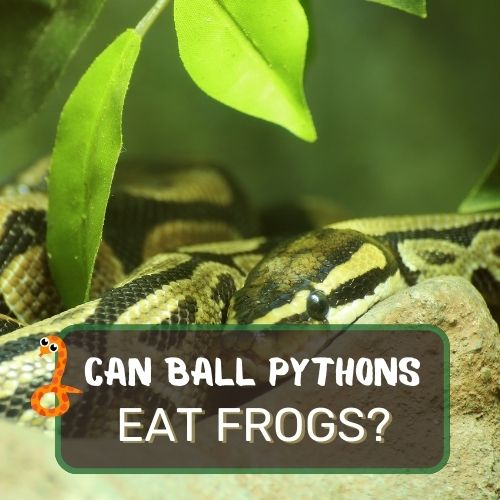
At first glance, it might seem like a straightforward query, but as with many things in nature, the answer is layered with fascinating details.
In this article, we delve deep into the dietary habits of ball pythons, both in the wild and in captivity.
We’ll explore the nutritional benefits frogs offer, the potential risks involved, and even guide you through the process if you’re considering this amphibian treat for your slithery friend. B
y the end, you’ll have a comprehensive understanding of this intriguing topic, armed with knowledge to make informed decisions for your pet python.
Dive in and discover the intricate dance between pythons and frogs in the wild world of reptiles!
Table of Contents
- 1 Can Ball Pythons Eat Frogs?
- 2 Ball Pythons in the Wild vs. Captivity
- 3 What Do Pet Ball Pythons Generally Eat?
- 4 Nutritional Benefits of Frogs for Ball Pythons
- 5 Potential Risks of Feeding Frogs to Ball Pythons
- 6 Choosing the Right Frog for Your Ball Python
- 7 A Step-by-Step Guide to Feeding Frogs to Your Ball Python
- 8 Conclusion
- 9 FAQ
Can Ball Pythons Eat Frogs?
Ball pythons, in their natural habitat, occasionally consume frogs as part of their varied diet. Frogs offer a source of protein and other essential nutrients beneficial for the snake. However, in captivity, most ball pythons are accustomed to eating warm-blooded prey, primarily rodents. While it’s possible to feed them frogs, it’s essential to ensure the amphibians are free from toxins and parasites.
Additionally, the frog’s size should be appropriate for the python to prevent choking. In summary, while ball pythons can eat frogs, it’s crucial to approach this dietary choice with caution and knowledge.
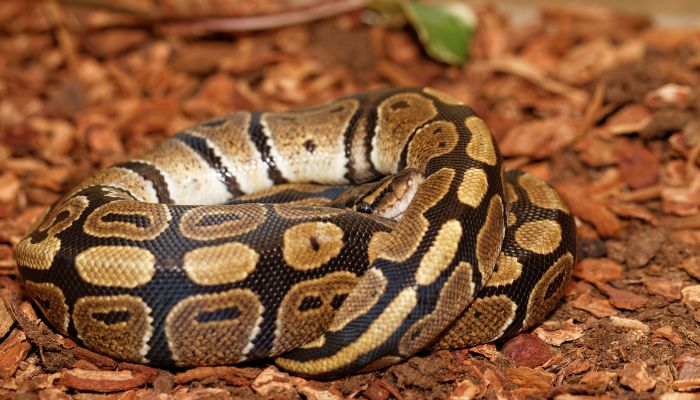
Ball Pythons in the Wild vs. Captivity
When you think of a ball python, you might imagine it slithering through the dense underbrush of West and Central Africa, hunting for its next meal. But what exactly does this meal consist of?
And how does it differ from what a captive ball python might eat in your living room terrarium?
Natural Diet of Ball Pythons in the Wild
In the wild, ball pythons are opportunistic feeders. This means they’ll eat whatever they can get their coils around. From small mammals to birds and, yes, even amphibians like frogs.
The wild ball python’s diet is a smorgasbord of whatever prey is available, ensuring their survival. Frogs, being relatively slower and easier to catch, often find themselves on the menu.
The wild is all about survival, and ball pythons aren’t picky when hunger strikes.
Differences in Diet Preferences Between Wild and Captive Ball Pythons
Now, let’s transport our ball python from the African wilderness to a cozy terrarium in someone’s living room. The captive ball python’s diet is often more controlled and consistent, primarily consisting of mice or rats.
This is because rodents are readily available, nutritious, and accepted by most pythons.
In captivity, the ball python’s diet is less about survival and more about convenience and nutrition. While they can eat frogs, it’s not a common practice for most snake owners.
This is partly due to the potential risks associated with feeding amphibians, such as toxins or parasites.
Why Some Captive Ball Pythons Might Not Be Interested in Frogs
Imagine being served the same dish every day. Over time, you’d develop a preference for it, right? Similarly, captive ball pythons, when fed a consistent diet of warm-blooded rodents, might develop a preference for them.
Frogs, being cold-blooded, don’t emit the same heat signature as rodents. Ball pythons, equipped with labial pits to detect heat, might not recognize a frog as potential prey, especially if they’ve never encountered one before.
The Usual Preference for Warm-Blooded Animals
Warm-blooded animals, like rodents, emit a distinct heat signature, making them easier for ball pythons to detect and hunt. This heat detection is crucial in the wild, where the snake relies on it to locate and ambush prey.
In captivity, this preference remains. The warmth of a mouse or rat is like a beacon, signaling a hearty meal. Frogs, on the other hand, might not spark the same interest, being cold-blooded and lacking that enticing warmth.
Ball pythons in the wild might munch on frogs now and then, while their captive counterparts have developed a distinct palate, favoring the warmth and familiarity of rodents.
It’s a fascinating insight into how environment and diet can shape an animal’s preferences.
So, the next time you see a ball python, remember: they’re not just simple creatures but products of their environment, each with unique dietary tales to tell.
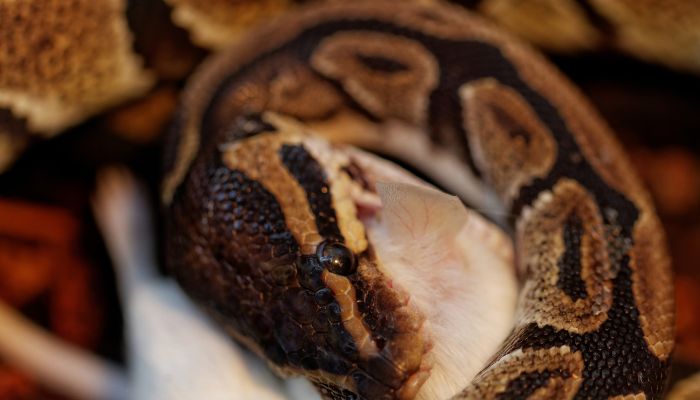
What Do Pet Ball Pythons Generally Eat?
Ball pythons, with their docile nature and captivating patterns, have become one of the most popular pet snakes worldwide. But, as with any pet, ensuring they receive a proper diet is paramount to their health and longevity.
So, what’s on the menu for these slithering companions?
Importance of a Diverse Diet for Ball Pythons
Variety is the spice of life, and this couldn’t be truer for ball pythons. A diverse diet ensures they receive all the essential nutrients they need. In the wild, their diet isn’t limited to just one type of prey.
They might feast on a bird one day and a frog the next.
Mimicking this variety in captivity can help in keeping the snake healthy and stimulated. It’s not just about nutrition; it’s also about providing an environment that’s as close to their natural habitat as possible.
Risks of Feeding the Same Prey for Extended Periods
Feeding your ball python the same prey repeatedly might seem convenient, but it comes with risks. A monotonous diet can lead to nutritional deficiencies.
Moreover, a snake that’s used to only one type of food might become a picky eater, refusing other prey items when introduced.
This can be particularly problematic if there’s a shortage of their preferred food or if they need a specific nutrient found in another prey type.
In captivity, ball pythons have a range of foods that cater to their carnivorous nature. Here’s a list of some of the most common foods they consume:
- Mice: A staple in the diet of many captive ball pythons. They can be offered live, frozen, or thawed.
- Rats: Another popular choice, especially for adult pythons. Rats provide more nutrition than mice and are often preferred as the snake grows.
- Chicks: Some owners introduce day-old chicks as a part of a varied diet, especially for larger pythons.
- Quail: A less common but nutritious option, suitable for larger ball pythons.
- Gerbils or Hamsters: Occasionally used as a treat or for picky eaters.
- African Soft-furred Rats: These are sometimes preferred due to their closer resemblance to the python’s natural prey in the wild.
- Frogs: While not a staple, some owners experiment with feeding frogs, especially if the snake shows interest.
It’s essential to ensure that the prey is appropriately sized, with the general guideline being that the prey’s width should not exceed the python’s widest girth. Always prioritize the health and safety of the snake when introducing new foods.
Age-Specific Dietary Needs and Prey Size Considerations
Just like humans, ball pythons have different dietary needs as they grow. Baby ball pythons, with their tiny size, start with small prey like pinkie mice. As they grow, their prey size should also increase.
A general rule of thumb is to offer prey that’s roughly the same width as the snake’s thickest part. Overfeeding or offering prey that’s too large can lead to health issues, including regurgitation or even injury.
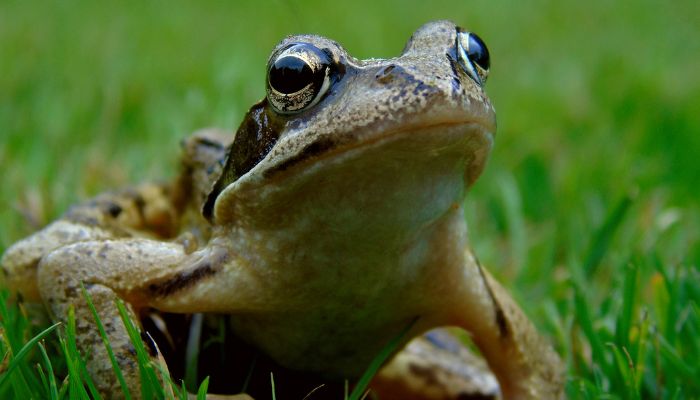
Nutritional Benefits of Frogs for Ball Pythons
When it comes to the diet of ball pythons, frogs might not be the first thing that comes to mind. However, these amphibians pack a nutritional punch that can be beneficial for our slithering friends.
Let’s dive into the world of froggy nutrition and see what they bring to the table—or should we say, the terrarium?
The Array of Nutrients Frogs Offer
Frogs aren’t just a tasty treat; they’re a nutritional powerhouse. They provide a balanced profile of essential amino acids, making them an excellent protein source. Beyond protein, frogs are rich in essential fatty acids, minerals, and vitamins.
This combination ensures that ball pythons get a well-rounded meal, supporting their overall health.
Frogs as a Source of High-Quality Protein
Protein is crucial for the growth, repair, and maintenance of body tissues. Frogs offer high-quality protein, which is easily digestible and assimilated by ball pythons.
This protein quality ensures that the snake gets the maximum benefit from its meal, supporting muscle growth and tissue repair.
Importance of Calcium, Water, and Other Vitamins in a Python’s Diet
Calcium plays a pivotal role in bone health, muscle function, and nerve signaling. Frogs, especially their bones, are a good source of this essential mineral. Additionally, the moisture content in frogs aids in keeping the python hydrated.
Vitamins, such as vitamin A found in frogs, support vision, growth, and immune function. Ensuring a diet rich in these nutrients helps in maintaining a healthy and active ball python.
Unique Health Benefits of Frogs, Such as Collagen and Carotenoids
Beyond the standard nutrients, frogs offer some unique health benefits. Their skin is rich in collagen, which can aid in maintaining the elasticity and health of the python’s skin.
Carotenoids, especially present in frog eyes, are known to enhance vision. While these benefits might be subtle, they contribute to the overall well-being of the snake.
Potential Risks of Feeding Frogs to Ball Pythons
Feeding frogs to ball pythons might sound like a natural choice, given their wild dietary habits. However, introducing frogs, especially those sourced from uncertain environments, can come with its set of challenges and risks.
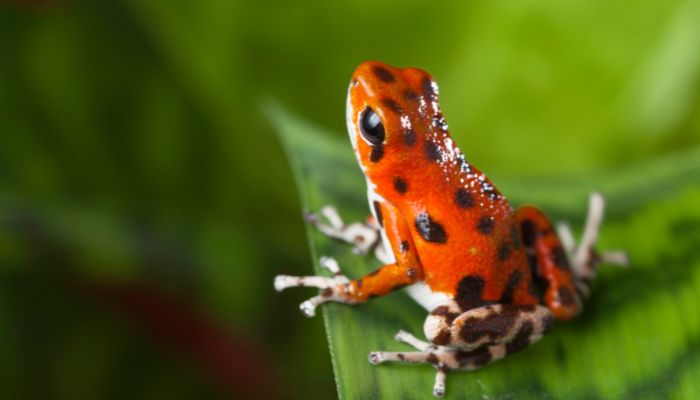
Parasites and Toxins: What to Watch Out For
One of the primary concerns when feeding frogs to ball pythons is the potential presence of parasites. Frogs can be carriers of various internal and external parasites that can be harmful to snakes when ingested.
These parasites can lead to digestive issues, malnutrition, and other health complications in pythons.
Additionally, certain frog species secrete toxins as a defense mechanism. While these toxins might deter predators in the wild, they can be harmful, even fatal, to ball pythons.
The Dangers of Wild-Caught Frogs
Wild-caught frogs pose a higher risk compared to those bred in controlled environments. Apart from the threat of parasites, wild frogs might have been exposed to pesticides, pollutants, and other contaminants that can be harmful to pythons.
Precautions to Take When Sourcing Frogs for Your Python
If you’re considering frogs as a dietary option for your ball python, it’s crucial to source them from reputable breeders or suppliers. Ensure the frogs are parasite-free and haven’t been exposed to harmful chemicals.
Quarantining and observing the frogs before feeding can also help in identifying potential issues.
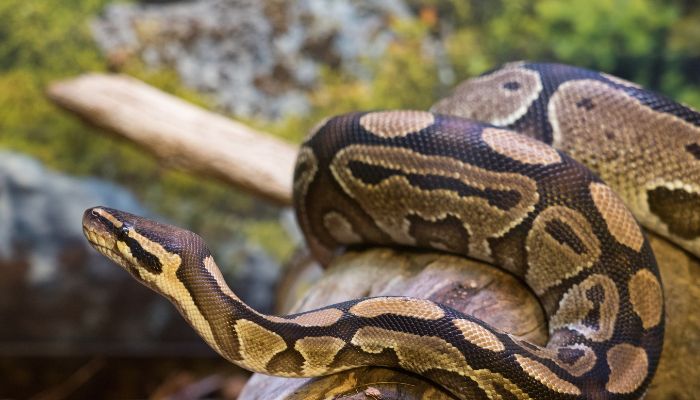
Choosing the Right Frog for Your Ball Python
Not all frogs are created equal, especially when it comes to feeding them to your ball python. Making an informed choice can ensure your python’s safety and health.
Species of Frogs That Are Safe for Ball Pythons
While many frog species can be potential prey for ball pythons, it’s essential to stick to those known to be safe. African dwarf frogs, Cuban Tree frogs, and African Clawed Frogs are popular choices among reptile enthusiasts.
These species are non-toxic and can be a nutritious addition to the python’s diet.
Popular Frog Options and Their Benefits
African dwarf frogs are small, making them suitable for younger or smaller pythons. They’re also readily available and relatively affordable.
Cuban Tree frogs and African Clawed Frogs are larger, making them a good choice for adult pythons. These species are also non-toxic and provide a good nutritional profile.
The Importance of Avoiding Poisonous Frogs
Some frogs, like the Poison Dart Frog, are known for their potent toxins. While they might look attractive and exotic, they’re a definite no-no for your ball python. Always research and ensure the frog species you’re considering is safe for consumption.
A Step-by-Step Guide to Feeding Frogs to Your Ball Python
Feeding frogs to your ball python can be a unique experience, both for you and your slithery friend. But, like any dietary change, it requires careful planning and execution. Here’s a detailed guide to ensure your python enjoys its amphibian treat safely.
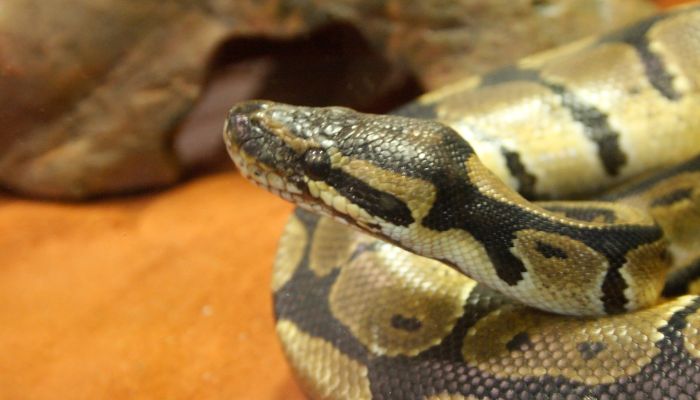
Sourcing Frogs of the Right Size
Size matters when it comes to feeding your ball python. The frog you choose should be proportionate to the size of your snake. A general rule of thumb is to offer prey that’s about the same width as the snake’s thickest part.
This ensures easy swallowing and digestion. For younger pythons, smaller frog species like the African dwarf frog might be ideal. For larger, adult pythons, you can consider bigger species like the Cuban Tree frog.
The Humane Way to Prepare Frogs for Feeding
Once you’ve sourced the right frog, it’s essential to prepare it humanely. If you’ve purchased live frogs, the most humane method to euthanize them is by placing them in a container and refrigerating for a few hours, followed by freezing.
This method ensures the frog goes into a torpid state before passing away. Once the frog is euthanized, thaw it to room temperature before offering it to your python.
Monitoring Your Ball Python During Feeding
Feeding time is a crucial moment to observe your python’s behavior. Place the frog in the terrarium and watch how your python reacts. Some pythons might be hesitant at first, especially if it’s their first time encountering a frog.
It’s essential to ensure the snake doesn’t struggle with the frog, especially if it’s a larger specimen. If the python shows signs of distress or difficulty, it might be best to remove the frog and try a smaller size next time.
What to Do if Your Python Doesn’t Eat the Entire Frog
It’s not uncommon for ball pythons to leave behind parts of their prey. If your python consumes only parts of the frog, like the legs, and leaves the rest, it’s essential to remove the uneaten portion promptly.
Leftover organic matter can decay quickly, leading to unpleasant odors and potential health risks for your snake. Always ensure the terrarium is clean after feeding to prevent bacterial growth.
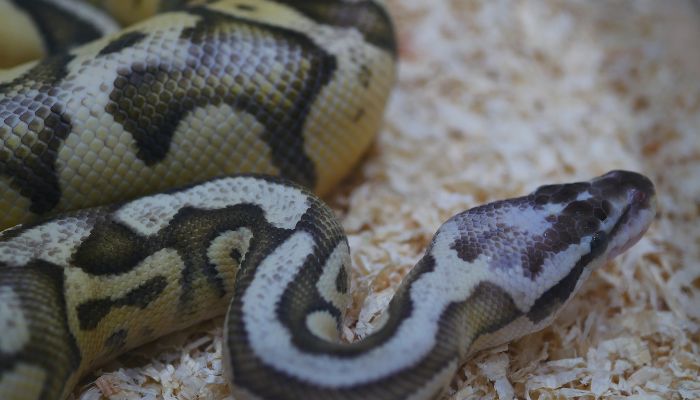
Conclusion
In your journey through this article, you’ve unraveled the intricate relationship between ball pythons and frogs.
You’ve discovered that while ball pythons in the wild might occasionally feast on frogs, those in captivity have a different set of dietary preferences and needs. The nutritional benefits of frogs are undeniable, from high-quality protein to essential vitamins.
Yet, it’s equally crucial to be aware of the potential risks, ensuring that any froggy treat is safe for your slithery companion.
Choosing the right diet for your ball python is a testament to your commitment as a pet owner. It’s about understanding, respect, and a desire to provide the best for your reptilian friend. Remember, every decision you make impacts their health and well-being.
As you move forward, use the knowledge you’ve gained here to make informed choices. Whether you decide to introduce frogs into your python’s diet or stick to more conventional prey, always prioritize their health and happiness.
You’re on a remarkable journey with your ball python, and every step you take is a chance to deepen that bond. Keep learning, stay curious, and continue being the fantastic pet owner you are!
FAQ
Navigating the world of reptiles and amphibians can be filled with questions, especially when it comes to their dietary habits and relationships. Here are some frequently asked questions to shed light on these intriguing creatures.
How Long Does it Take for a Snake to Eat a Frog?
The time it takes for a snake to consume a frog can vary based on the snake’s size, the frog’s size, and the snake’s experience with this type of prey. Typically, a ball python might take anywhere from 10 minutes to an hour to fully consume a frog. It’s essential to monitor the snake during this time to ensure it doesn’t face any difficulties.
What Snakes Eat Frogs?
Many snake species include frogs in their diet. Apart from ball pythons, other snakes like garter snakes, water snakes, and some species of king snakes are known to consume frogs. In the wild, any snake that comes across a frog and can overpower it might consider it a meal.
Are Snakes and Frogs Closely Related?
While both snakes and frogs fall under the category of cold-blooded animals, they aren’t closely related. Snakes are reptiles, while frogs are amphibians. The primary distinction is that reptiles have scales and lay eggs on land, while amphibians have smooth skin and often lay eggs in water. Their evolutionary paths diverged quite some time ago, leading to the distinct species we see today.




0 Comments